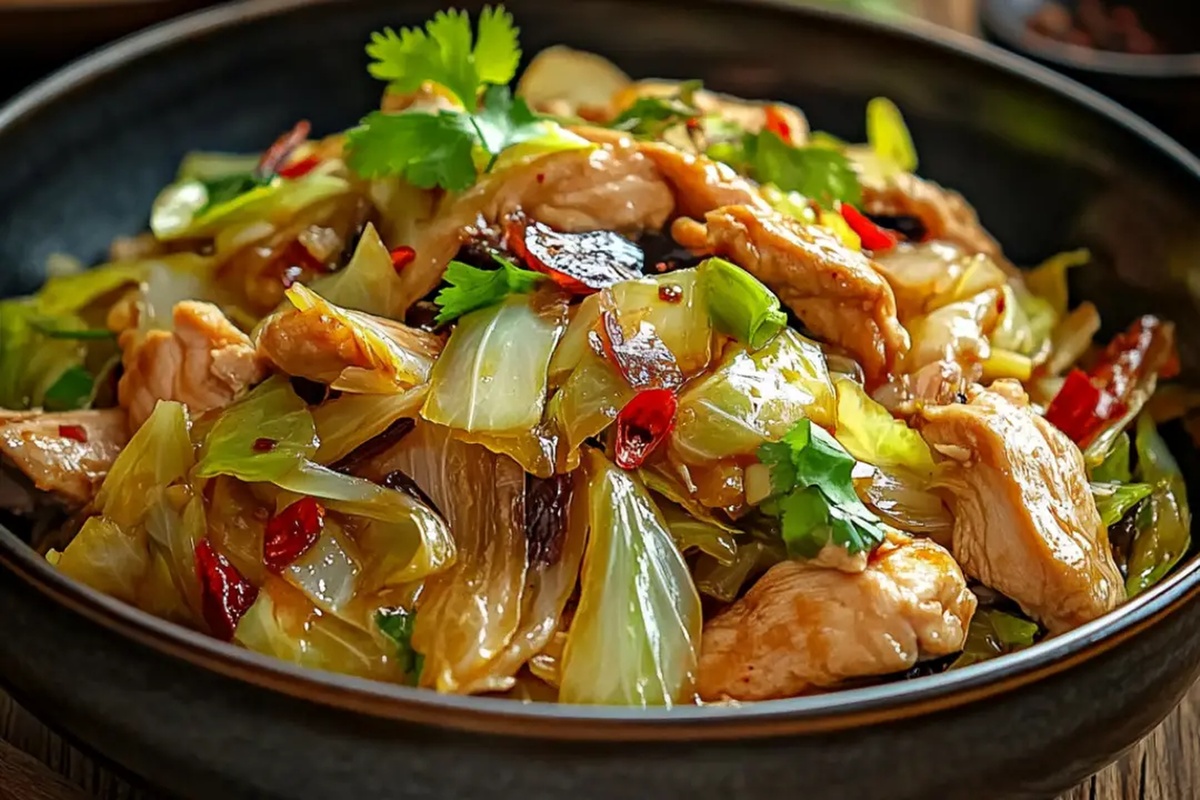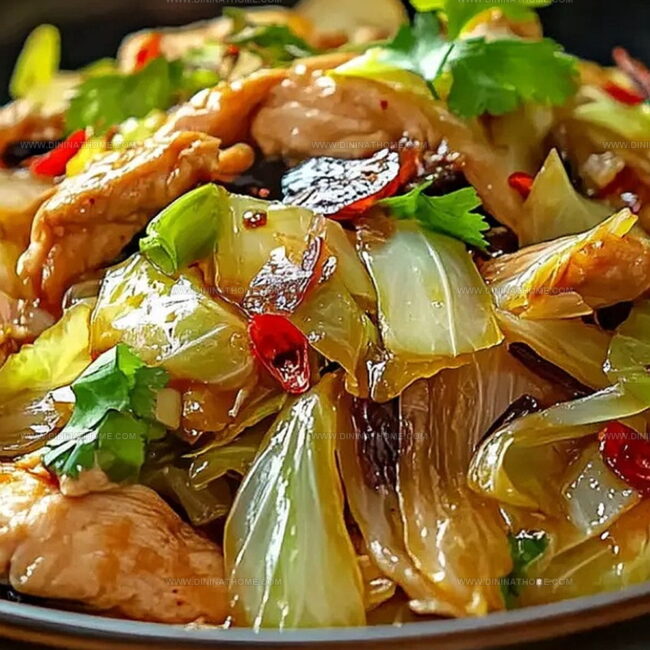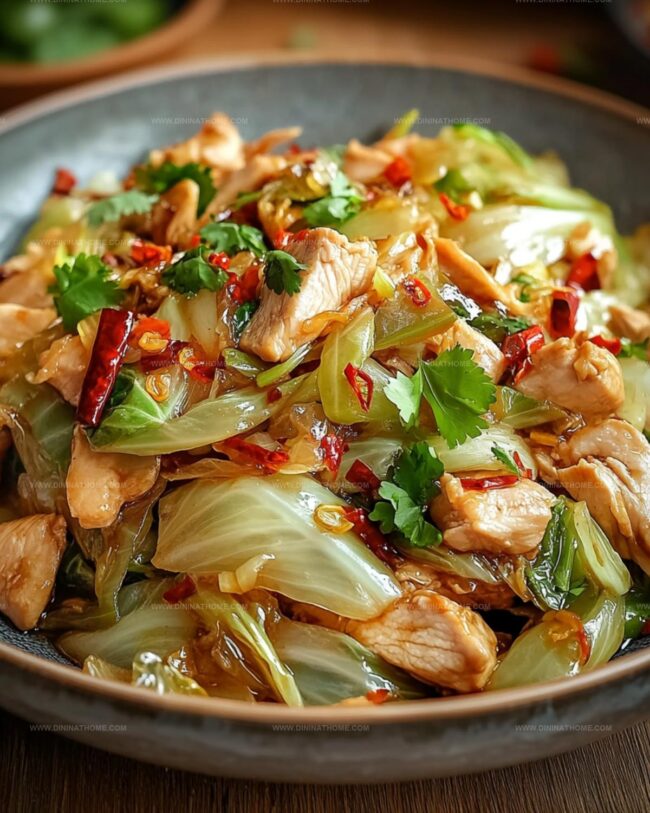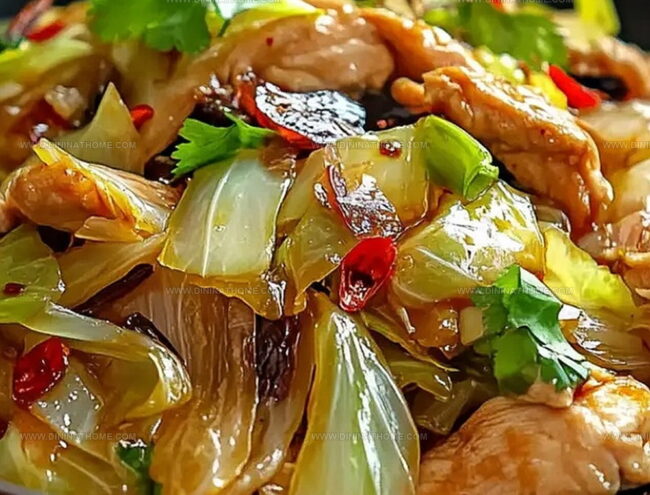Tasty Chinese Chicken Cabbage Stir-Fry Recipe for Busy Nights
Whipping up a quick and delectable chinese chicken cabbage stir-fry can turn an ordinary weeknight into a culinary adventure.
Crisp vegetables dance with tender meat in this classic Asian-inspired dish.
Forget complicated cooking techniques that drain your energy.
Each bite promises a perfect balance of savory and fresh flavors.
Minimal ingredients combine to create maximum satisfaction in your kitchen.
Pantry staples become a delightful meal that surprises and delights.
Let’s uncover how simple ingredients can become an extraordinary dinner that sparks joy at your table.
Chicken Cabbage Stir-Fry With Chinese Flavors
Chinese Chicken Cabbage Stir-Fry What to Prepare
Main Protein:Vegetables:Sauce and Seasoning:Cooking Base:Stir Fry Instructions for Cabbage and Chicken the Chinese Way
Step 1: Create Flavor-Packed Sauce
Blend these ingredients in a small bowl:Mix thoroughly until smooth and set aside.
Step 2: Awaken The Aromatics
Heat vegetable oil in a wok over high heat.
Toss in minced garlic and grated ginger, stirring quickly for about 30 seconds until the kitchen fills with an incredible fragrance.
Step 3: Sear The Chicken
Add chicken strips to the wok, cooking and moving them around for 2-3 minutes until they develop a beautiful golden-brown color.
Step 4: Introduce Crispy Cabbage
Slide chopped Chinese cabbage into the wok, continuing to stir-fry for another 2-3 minutes.
The cabbage should remain slightly crunchy but softened.
Step 5: Bring It All Together
Pour the prepared sauce over the chicken and cabbage.
Stir rapidly for one minute, allowing the sauce to thicken and lovingly coat every morsel.
Step 6: Final Seasoning And Serve
Sprinkle salt and pepper to enhance the flavors.
Transfer the sizzling stir-fry to a serving plate and enjoy immediately with steamed rice.
Stir-Fry Tips for Crisp Cabbage & Juicy Chicken
Reheat Chicken Cabbage Stir-Fry
Simple Pairings for Chinese Chicken Cabbage Stir-Fry
Chicken Cabbage Stir-Fry with Veggie Switches
FAQs
Yes, cornstarch helps thicken the sauce and create a glossy coating on the chicken and cabbage, giving the dish a professional restaurant-style texture.
Napa cabbage works best for this stir-fry, but you can substitute with green or white cabbage if needed. Just ensure you chop it into similar-sized pieces for even cooking.
Slice chicken against the grain into thin, uniform strips about 1/4 inch thick. This ensures quick, even cooking and tender meat that absorbs the sauce well.
Cook chicken on high heat for a short time, and avoid overcrowding the wok. Keep the chicken moving constantly to ensure it stays juicy and doesn’t steam or become rubbery.
Print
Chinese Chicken Cabbage Stir-Fry Recipe
- Total Time: 20 minutes
- Yield: 4 1x
Description
Sizzling Chinese chicken cabbage stir-fry brings authentic Asian flavors straight to your kitchen. Crisp vegetables and tender chicken dance together in a quick, savory meal that delivers robust taste and nutritional balance.
Ingredients
Main Protein:
- 1 lb (454 g) boneless chicken breast, sliced into thin strips
Vegetables:
- 1 small Chinese cabbage, chopped into bite-sized pieces
- 2 cloves of garlic, minced
- 1 inch (2.5 cm) ginger, peeled and grated
Seasoning and Cooking Liquids:
- 2 tablespoons (30 ml) vegetable oil
- 2 tablespoons (30 ml) soy sauce
- 1 tablespoon (15 ml) oyster sauce
- 1 teaspoon (5 ml) cornstarch
- 1/4 cup (60 ml) water
- Salt, to taste
- Pepper, to taste
Instructions
- Whisk together soy sauce, oyster sauce, cornstarch, and water in a compact mixing vessel, creating a smooth, glossy marinade for later use.
- Fire up a wok over intense heat, allowing the cooking surface to become searing hot and ready for rapid culinary action.
- Tumble minced garlic and grated ginger into the scorching wok, releasing their aromatic essence and creating a fragrant base for the stir-fry.
- Introduce chicken strips into the sizzling environment, allowing them to caramelize and develop rich golden edges while maintaining tender interiors.
- Fold crisp Chinese cabbage into the wok, tossing vigorously to ensure even heat distribution and preserve the vegetable’s vibrant texture and slight crispness.
- Stream the prepared sauce mixture over the sizzling ingredients, stirring continuously to help the liquid transform into a glossy, clingy coating that embraces every morsel.
- Modulate the seasoning with precise pinches of salt and freshly cracked pepper, ensuring a balanced flavor profile that complements the dish’s robust character.
- Transfer the piping hot stir-fry onto a bed of steamed rice, creating a harmonious and satisfying meal that celebrates Chinese culinary traditions.
Notes
- Ensure the wok is scorching hot before adding ingredients to achieve that signature wok hei flavor and prevent soggy vegetables.
- For a lighter version, swap chicken with tofu or lean protein like turkey breast and use low-sodium soy sauce to reduce calories.
- Slice cabbage and chicken uniformly to guarantee even cooking and consistent texture throughout the stir-fry.
- Prep all ingredients before starting to cook, as stir-frying happens quickly and requires immediate attention to prevent burning.
- Prep Time: 10 minutes
- Cook Time: 10 minutes
- Category: Lunch, Dinner
- Method: Sautéing
- Cuisine: Chinese
Nutrition
- Serving Size: 4
- Calories: 290
- Sugar: 2 g
- Sodium: 800 mg
- Fat: 12 g
- Saturated Fat: 2 g
- Unsaturated Fat: 8 g
- Trans Fat: 0 g
- Carbohydrates: 14 g
- Fiber: 2 g
- Protein: 30 g
- Cholesterol: 80 mg





James Walker
Lead Recipe Developer & Culinary Educator
Expertise
Southern Cuisine & Farm-to-Table Cooking, Recipe Development & Testing, Culinary Education & Instruction
Education
School: Auguste Escoffier School of Culinary Arts
Program: Diploma in Culinary Arts and Operations
Focus: Comprehensive training in classical and modern culinary techniques, kitchen operations, and farm-to-table practices.
James didn’t learn cooking from a TV show, he learned it from busy kitchens, family gatherings, and long afternoons spent testing recipes the hard way.
After training at the Auguste Escoffier School of Culinary Arts, he brought his love for real, down-to-earth food to every dish he makes.
At Dining At Home, James loves building recipes that feel familiar but still have something special, like adding a twist to a classic or making a slow Sunday dinner feel brand new.
When he’s not in the kitchen, you’ll probably find him swapping garden tips at the farmers’ market or teaching his daughter how to flip pancakes without a mess (almost).